Coffee Guides
Optimal Coffee Measures for 10 Cups Brewed
Discover the perfect ratio of coffee to water for a delicious 10-cup brew. Learn how much coffee for 10 cups you’ll need for the ideal pot.

Have you ever wondered why your coffee doesn’t quite taste right even after following standard guidelines? Mastering the art of coffee brewing can be perplexing, especially when aiming to brew a perfect 10-cup pot. Understanding the intricate coffee to water ratio becomes pivotal in brewing that flawless pot. Carafe markings on your drip coffee maker often denote a cup as 5-6 oz, not the typical 8 oz standard, which can lead to confusion. So, what’s the secret to brewing that impeccable 10-cup pot?
General advice suggests using 2 tablespoons (one coffee scoop) per 6 oz of water, which tallies up to 20 tablespoons for 10 cups. However, elevating your brew experience involves weighing coffee grounds with a kitchen scale. The Specialty Coffee Association’s golden ratio recommends 55 grams of coffee per liter of water, or 1:18, enhancing the coffee’s quality. Opting for high-quality beans, such as Driven Coffee’s medium roast, can also significantly impact the flavor. It’s crucial to confirm the accuracy of the carafe’s measurements as they may vary.
Key Takeaways
- Understanding carafe markings is crucial for accurate measuring coffee for 10 cups.
- Use 2 tablespoons (1 coffee scoop) per 6 oz cup for standard measurements.
- Weigh coffee grounds using a kitchen scale to follow the golden ratio of 55 grams of coffee per liter of water.
- Quality of coffee, such as Driven Coffee’s medium roast, significantly affects the final brew.
- Measurement accuracy is vital, as carafe markings can vary.
Introduction to Brewing 10 Cups of Coffee
When planning on brewing large batches of coffee, it’s crucial to emphasize the importance of consistency. Consistent coffee brewing ensures that each cup has a balanced flavor profile and meets the same quality standard every time. By understanding and maintaining uniform coffee maker measurements, you can enjoy the perfect pot with less guesswork.
The Importance of Consistency
Consistency in coffee brewing is paramount because it impacts not just the taste but also the overall coffee experience. When you standardize your coffee measurements, from the coffee grounds to the water used, you eliminate variables that could alter the coffee’s quality. This is particularly vital when brewing large batches of coffee, as even slight variations can significantly affect the outcome.
Common Measurements Used
Using consistent measurements is key to achieving the desired flavor. A standard measurement for a coffee scoop is equivalent to 2 tablespoons, translating to about 11 grams. For those who prefer precision, a tablespoons to grams conversion can be used. Understanding these conversions and utilizing a coffee scoop or kitchen scale ensures that every brew is as perfect as the last.
Typical coffee maker measurements regard a standard cup as 6 oz rather than the conventional 8 oz. Hence, using the correct coffee scoop and maintaining the same ratio of coffee to water each time you brew helps in achieving the best results. Adhering to the consistent use of these measurements can greatly enhance the brewing process and the coffee’s final taste.
Understanding Coffee Measurements
When it comes to coffee measurement methods, the distinction between volume and weight is crucial. Each measurement type offers its own pros and cons, especially considering the density variations among different coffee grinds. Accurately measuring your coffee can make a noticeable difference in your brewing experience.
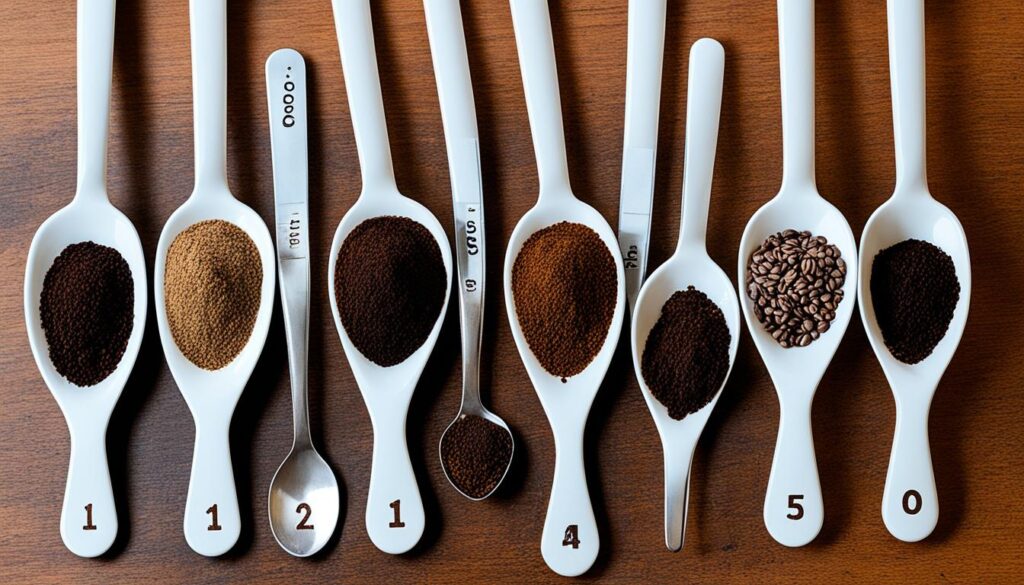
Volume vs. Weight
Using volume measures like scoops and tablespoons might seem convenient; however, these methods can often result in inconsistencies. Coffee grounds have varying densities, meaning one scoop of finely ground coffee may weigh more than a scoop of coarsely ground coffee. Therefore, relying solely on volume rather than weight can lead to inaccurate coffee brewing.
The Role of Coffee Scoops
Utilizing coffee scoops is a common practice among many coffee enthusiasts. Typically, one coffee scoop contains about 2 tablespoons of coffee, translating to roughly 11 grams. While this approach offers a quick and easy coffee measurement method, it might not be the most precise due to differences in coffee density and grind size. For consistent and accurate brewing, a more precise technique could be beneficial.
Why Use a Kitchen Scale?
The benefits of a kitchen scale in coffee brewing are substantial. Measuring coffee grounds by weight ensures that regardless of the grind size or coffee density, the coffee to water ratio remains constant. This practice leads to accurate coffee brewing, adhering to the ideal measurements of about 55 grams of coffee per liter of water, often referred to as the “Golden Ratio.” This precision makes a kitchen scale an invaluable tool for any coffee aficionado aiming for the perfect cup every time.
| Measurement Method | Benefits | Drawbacks |
|---|---|---|
| Volume (Scoops and Tablespoons) | Quick, Convenient | Inconsistent due to grind density variations |
| Weight (Kitchen Scale) | Precise, Consistent | Requires additional equipment |
The Golden Ratio
The *Golden Ratio of coffee* is a brewing benchmark established by the *Specialty Coffee Association standards*. It typically involves using 55 grams of coffee per liter of water, which equates to a coffee to water ratio of approximately 1:18. This standard helps ensure a balanced and flavorful cup each time you brew.

For those wondering how to perfect the *coffee to water ratio*, understanding this ratio is key. Generally, it translates to roughly 15 grams of coffee for every 250 mL (about 8.5 oz) of water. However, personal preferences can vary the perfect coffee brew ratio from 1:15 to 1:18, allowing adjustments for a stronger or milder taste.
In practical terms, if you are using a drip coffee maker, it is advisable to start with a 1:16 ratio. This serves as a happy medium and a great starting point for achieving the perfect coffee brew ratio. Fine-tuning the balance according to one’s individual taste can lead to delightful discoveries in one’s coffee experience.
Here is a quick reference guide to the Golden Ratio across different volumes:
| Water Volume | Coffee Grounds | Ratio |
|---|---|---|
| 1 Liter | 55 grams | 1:18 |
| 500 mL | 27.5 grams | 1:18 |
| 250 mL | 15 grams | 1:16.7 |
| 125 mL | 7.5 grams | 1:16.7 |
By using these guidelines, coffee enthusiasts can easily adhere to the Specialty Coffee Association standards and tweak their methods to find their own perfect coffee brew ratio.
How Much Coffee for 10 Cups
Determining the ideal coffee measurement for a 10-cup brew can make a substantial difference in taste and satisfaction. To start with, using coffee scoops simplifies the process. Most guidelines recommend one coffee scoop of grounds per cup, where one scoop equals 2 tablespoons. For a standard 10-cup pot, this translates to using 10 scoops or 20 tablespoons of coffee, which equals around 110 grams, assuming a 1:16 coffee-to-water ratio.
Using Coffee Scoops
Using coffee scoops for 10 cups is convenient and straightforward, especially when aiming for consistency in your daily brew. Each scoop helps maintain a measurable amount of coffee, ensuring you achieve the same strength and flavor each time. Whether you’re using a drip coffee maker or a French press, keeping to the standard one scoop per cup ensures a harmonious balance between the coffee and water ratios. This method aligns with common practices, providing a reliable starting point for most brewing methods.
Adjustments Based on Personal Taste
While the standard measurements provide a useful guideline, personal taste adjustments are essential for tailoring your coffee to your preference. Some might prefer a stronger brew and might add an additional scoop or two, while others might enjoy a milder cup by reducing the amount slightly. Experimenting with coffee brewing customization helps you find your ideal coffee measurements. Whether it’s finding the sweet spot within the 1:15 to 1:18 ratio range or tweaking the amount based on coffee freshness and grind size, these adjustments are key to achieving a brew that’s uniquely yours.
FAQ
What is the optimal coffee to water ratio for brewing 10 cups of coffee?
Why is it important to understand coffee maker measurements?
How can I achieve consistency in brewing larger batches of coffee?
What common measurements are used for making coffee?
Which is more accurate for measuring coffee: volume or weight?
What is the purpose of a coffee scoop in measuring grounds?
Why should I use a kitchen scale for brewing coffee?
What is the Golden Ratio of coffee?
How do I measure coffee for a 10-cup pot using coffee scoops?
Can I adjust coffee measurements based on personal taste?
Ryze Coffee
10 Mushroom Coffee Vs Ryze Mushroom Coffee – Which One Reigns Supreme?
Struggling to choose between 10 Mushroom Coffee and Ryze Mushroom Coffee? Discover which brand truly reigns supreme for your taste and health goals!

When you're deciding between 10 Mushroom Coffee and Ryze Mushroom Coffee, it all comes down to your taste and health goals. 10 Mushroom Coffee, like Four Sigmatic, is known for its smooth flavor and effective adaptogens, making it a crowd favorite. Ryze, on the other hand, packs a punch with a higher caffeine content and an earthy taste, which some find less appealing. If you want digestive support and a pleasant coffee experience, 10 Mushroom Coffee may be the way to go. Stick around to discover which brand might be the best fit for your needs.
Key Takeaways
- Four Sigmatic boasts higher user satisfaction ratings (4.3/5 stars) compared to Ryze, which struggles with taste and texture complaints.
- Four Sigmatic offers a smoother flavor profile, while Ryze is noted for its earthy, bitter taste.
- Four Sigmatic provides 50-70 mg of caffeine per serving, delivering a milder energy boost than Ryze's stronger 90 mg per serving.
- Health benefits differ; Four Sigmatic focuses on digestive and immune support, while Ryze emphasizes physical performance and energy enhancement.
Overview of Mushroom Coffee
Mushroom coffee, often enjoyed by health enthusiasts, blends traditional coffee with adaptogenic mushrooms to create a unique beverage that's both flavorful and beneficial. This innovative drink gained popularity after its origins in Finland during WWII when coffee beans became scarce. Today, it's celebrated for its health benefits, particularly those associated with the Lion's Mane mushroom, known for boosting cognitive function and enhancing mental clarity.
Typically, mushroom coffee features a 1:1 ratio of coffee to mushroom extracts, ensuring you enjoy a rich flavor profile while reaping the advantages of organic ingredients. The taste is often earthy and toasty, mimicking regular coffee without overwhelming mushroom notes, making it appealing to many coffee lovers.
Another significant advantage of mushroom coffee is its lower caffeine content compared to traditional coffee. This gentler option provides an energy boost without the jitters, making it suitable for those sensitive to caffeine. By integrating adaptogenic mushrooms, you not only experience a delicious beverage but also support your overall well-being.
Brand Profiles: Four Sigmatic Vs. Ryze
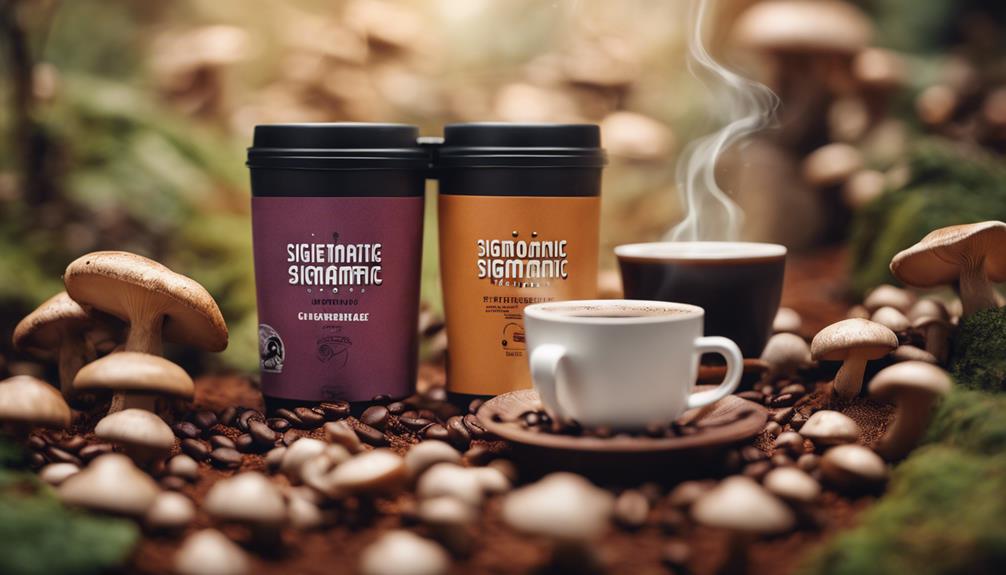
When comparing Four Sigmatic and Ryze, you'll find distinct differences in flavor, ingredients, and customer satisfaction that can influence your choice of mushroom coffee.
Four Sigmatic is a well-established brand known for its delicious mushroom-infused coffee, featuring a blend of Lions Mane and Chaga mushrooms. With a solid 4.3/5 star rating from nearly 18,000 reviews on Amazon, it stands out for its superior taste and effectiveness.
On the other hand, Ryze Mushroom Coffee contains a blend of eight ingredients, including Lions Mane and Cordyceps, but it has garnered lower ratings and fewer reviews. Many customers note its earthy and slightly bitter flavor, which mightn't appeal to everyone.
While Ryze offers a higher 6 grams of mushroom blend per serving, Four Sigmatic provides 2.5 grams. Both fall short of the recommended 1000 mg dose of Lions Mane for ideal health benefits.
Both brands prioritize organic and GMO-free ingredients, appealing to health-conscious consumers. Despite Ryze's social media buzz, Four Sigmatic is generally favored for its taste, user satisfaction, and strong presence in the mushroom coffee market.
Ingredient Comparison

When comparing the ingredients in Four Sigmatic and Ryze, you'll notice key differences in quality and dosage.
You'll want to evaluate the efficacy of the mushroom blends each brand offers and how they stack up against recommended amounts.
Additionally, think about the extra nutritional benefits that might enhance your coffee experience.
Ingredient Quality Analysis
Analyzing the ingredient profiles of Four Sigmatic and Ryze reveals significant differences in their blends and potential health benefits.
Four Sigmatic features a 2.5-gram blend per serving that includes coffee, Lion's Mane, Chaga, and Rhodiola Extract. On the other hand, Ryze offers a more substantial 6-gram blend, incorporating Lion's Mane, Cordyceps, and other ingredients aimed at performance enhancement.
Both brands prioritize ingredient quality, using organic and GMO-free components that attract health-conscious consumers. Four Sigmatic's Chaga is recognized for its digestive and immune support benefits, while Ryze's blend is designed to help with stress reduction and physical performance. However, neither brand meets the efficacious dose of 1000 mg for Lion's Mane, raising questions about their overall effectiveness.
Additionally, both brands fail to provide detailed dosage information for each ingredient, which makes it difficult for you to assess their health benefits fully.
While both options boast quality ingredients, the differences in their blends and the lack of transparency may influence your decision on which mushroom coffee to choose.
Dosage and Efficacy
The differences in dosage between Four Sigmatic and Ryze Coffee directly impact their potential efficacy and health benefits. Four Sigmatic provides 2.5 grams of a mushroom blend per serving, which includes Lion's Mane and Chaga. In contrast, Ryze Coffee boasts a more substantial 6 grams of mushroom content, featuring Lion's Mane and Cordyceps. However, neither brand meets the efficacious dose of 1000 mg for Lion's Mane, raising concerns about their effectiveness.
While Four Sigmatic's Chaga is recognized for its digestive and immune support, Ryze Coffee incorporates additional ingredients aimed at enhancing physical performance and reducing stress. Despite these offerings, Four Sigmatic enjoys a higher average consumer rating of 4.3 out of 5 stars on Amazon, suggesting a better overall user experience regarding perceived efficacy.
Both products, however, lack transparency in disclosing individual dosage information for their mushroom components. This absence of clarity makes it challenging for you, the consumer, to fully assess the specific health benefits you might receive from either product.
Ultimately, your choice may hinge on ingredient preferences and the perceived effectiveness highlighted by consumer ratings.
Additional Nutritional Benefits
While both Four Sigmatic and Ryze Coffee offer unique nutritional benefits, their ingredient compositions highlight distinct advantages tailored to different health goals.
Four Sigmatic features a blend of 2.5 grams of coffee with Lions Mane, Chaga mushrooms, and Rhodiola Extract, providing digestive and immune support. This combination appeals to health-conscious consumers seeking adaptogenic benefits and a smoother taste experience.
On the other hand, Ryze Coffee includes a more robust 6 grams of ingredients, featuring Lions Mane and Cordyceps. This formulation emphasizes additional nutritional benefits aimed at enhancing physical performance and reducing stress, making it suitable for those who prioritize energy and alertness.
However, neither brand meets the efficacious dose of 1000 mg for Lions Mane, leading to questions about the effectiveness of their mushroom content.
Both options are organic and GMO-free, aligning with the values of health-conscious consumers. Ultimately, your choice will depend on your specific health goals—whether you lean towards Four Sigmatic's focus on taste and adaptogens or Ryze's emphasis on performance and cognitive function in your mushroom coffee experience.
Taste Test Results

When it comes to taste, you'll notice distinct differences between Four Sigmatic and Ryze.
Many users prefer the smoother flavor profile of Four Sigmatic, while Ryze's earthy bitterness can be off-putting.
Let's explore how brewing methods and user preferences shape these taste test results.
Flavor Profiles Compared
Taste tests reveal that Four Sigmatic offers a smoother, more enjoyable flavor profile, setting it apart from the earthier, slightly bitter notes of Ryze Coffee. Many users appreciate Four Sigmatic's subdued and toasty taste, which enhances the overall drinking experience. On the other hand, Ryze Coffee's earthy flavor may not appeal to everyone and has received mixed feedback.
User reviews indicate that Four Sigmatic boasts a higher satisfaction rating of 4.3 out of 5 stars on Amazon, supported by nearly 18,000 reviews. This positive reception largely stems from its superior blend quality and taste. In contrast, Ryze has struggled to achieve similar acclaim, with lower ratings and fewer reviews. Common complaints about Ryze often focus on its uninviting flavor and texture, despite attempts to enhance its profile.
While Ryze allows for customization with milk, creamers, and sweeteners, many find that Four Sigmatic's natural flavor stands out without needing any alterations. Overall, if taste is your priority, Four Sigmatic seems to reign supreme in the mushroom coffee arena.
Brewing Method Impact
How does your choice of brewing method affect the flavor of mushroom coffee? The brewing methods you select can drastically change how your coffee tastes, especially with brands like Four Sigmatic and Ryze. Four Sigmatic typically provides consistent results across various methods, enhancing its flavor profiles. In contrast, Ryze's earthy flavor remains unchanged, potentially leading to a less satisfying experience for some.
Here's a quick comparison of how different brewing methods impact each brand:
| Brewing Method | Four Sigmatic Flavor | Ryze Flavor |
|---|---|---|
| Pour-over | Smooth, rich | Earthy, bitter |
| French Press | Full-bodied | Earthy, bitter |
| Automatic Drip | Balanced | Earthy, bitter |
| Cold Brew | Invigorating | Earthy, bitter |
| Espresso | Intense, smooth | Earthy, bitter |
Consumer feedback highlights that Four Sigmatic's adaptability across brewing methods leads to a more pleasant taste experience, whereas Ryze's flavor may not appeal universally. If you're looking for a versatile option, Four Sigmatic seems to reign supreme in the brewing method impact.
User Preference Insights
Many users overwhelmingly prefer Four Sigmatic for its smoother taste and overall enjoyable experience compared to Ryze. With a rating of 4.3 out of 5 stars on Amazon from nearly 18,000 reviews, Four Sigmatic stands out for its superior flavor profile. Users appreciate how it adapts well to various brewing methods, enhancing the coffee alternative experience.
In contrast, Ryze Mushroom Coffee tends to have an earthy, slightly bitter flavor that doesn't resonate with all consumers. This leads to lower ratings and fewer reviews, with many voicing dissatisfaction about its taste and texture. Despite attempts to improve its flavor, Ryze's taste remains largely unchanged, which affects user satisfaction negatively.
Negative feedback regarding Four Sigmatic often relates to its effectiveness compared to regular coffee, but that doesn't seem to overshadow its flavor appeal. Overall, consumer preference clearly leans towards Four Sigmatic, as its enjoyable taste and texture make it a favored choice among mushroom coffee enthusiasts.
If you're looking for a satisfying brew, Four Sigmatic may just be the ideal option for you.
Health Benefits Analysis
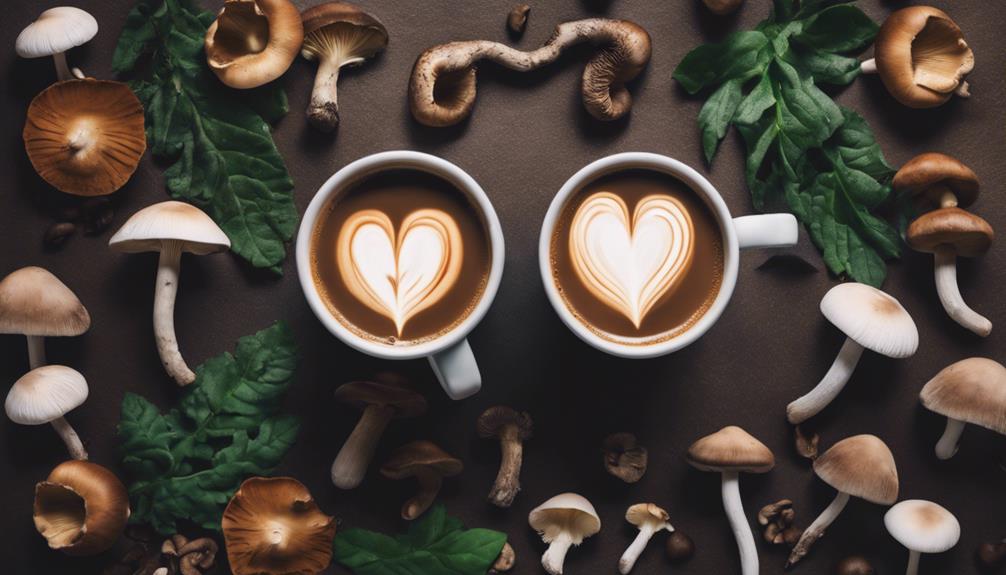
Mushroom coffee offers a blend of cognitive and immune support, thanks to its key ingredients like Lion's Mane and Chaga. Both Four Sigmatic and Ryze Mushroom Coffee harness these adaptogenic mushrooms to enhance cognitive function and bolster your immune system.
While Four Sigmatic includes 2.5 grams of mushrooms per serving, Ryze ups the ante with 6 grams. However, neither brand meets the 1000 mg recommended dose of Lion's Mane for ideal benefits.
Chaga, present in Four Sigmatic, provides additional digestive and immune support, contributing to your overall wellness. With lower caffeine content than regular coffee, mushroom coffee is an excellent choice for anyone sensitive to caffeine, allowing you to enjoy sustained energy without the jitters.
Regular consumption may also yield antioxidant benefits, helping to improve overall health and reduce the risk of chronic diseases. So whether you choose Four Sigmatic or Ryze, you're likely to experience these health benefits, making mushroom coffee a compelling alternative to traditional coffee.
Enjoy the cognitive boost and immune support while savoring a delicious cup!
Caffeine Content Breakdown

When you compare the caffeine levels in mushroom coffee options, you'll notice some interesting differences.
Four Sigmatic offers a milder boost with 50-70 mg per serving, while Ryze gives you about 90 mg for a stronger kick.
Understanding these variations can help you choose the right option for your energy needs and how long that boost might last.
Caffeine Levels Comparison
In comparing caffeine levels, Ryze Mushroom Coffee stands out with about 90mg of caffeine per cup, delivering a strong energy boost that outpaces many alternatives. This robust caffeine content makes it a fantastic choice for those needing a quick pick-me-up.
In contrast, Four Sigmatic generally features lower caffeine levels due to its unique blend of mushrooms and less coffee, making it a milder option for consumers seeking to limit their caffeine intake.
If you're looking for something even lighter, consider NoonBrew, which contains only 30mg of caffeine from organic Oolong tea. While both Ryze and Four Sigmatic offer lower caffeine than traditional coffee, Ryze gives you that extra kick when you need it most.
For instance, Ryze's matcha option provides about 30mg of caffeine per serving, allowing for a sustained energy release thanks to L-theanine.
Energy Boost Duration
Understanding how long the energy boost lasts from different coffee options can help you make a better choice based on your daily activities and caffeine tolerance.
Ryze Mushroom Coffee packs around 90mg of caffeine per cup, giving you a strong and immediate energy boost. This means you can expect a quick lift when you need it most.
On the other hand, Four Sigmatic's mushroom coffee offers a lower caffeine content, typically less than Ryze. This makes it ideal if you prefer a milder energy experience without the risk of jitters or a crash later on. If you're sensitive to caffeine, Four Sigmatic might be the better option for you.
For those considering alternatives, matcha delivers about 30mg of caffeine and provides a more gradual energy release thanks to its L-theanine content. This makes it a great choice if you want sustained energy without the abrupt peaks.
Ultimately, your choice between Ryze and Four Sigmatic depends on your desired energy boost duration and how your body reacts to caffeine. Understanding these differences will help you make an informed decision.
User Experience and Reviews

User experiences reveal a clear preference for Four Sigmatic, which boasts a higher satisfaction rate and more positive reviews compared to Ryze Mushroom Coffee.
With an impressive rating of 4.3/5 stars from nearly 18,000 reviews, Four Sigmatic users frequently praise its taste and smooth texture. They appreciate the rich flavor and how well it adapts to different brewing methods, leading to a consistently enjoyable user experience.
On the other hand, Ryze Mushroom Coffee has garnered lower ratings and fewer reviews. Many users express dissatisfaction with its earthy, slightly bitter flavor, which doesn't seem to improve with different preparation techniques. This lack of versatility in flavor contributes to a less favorable overall experience.
While some negative reviews for Four Sigmatic mention a perceived lack of effectiveness compared to regular coffee, the consensus leans heavily toward its superior taste and user satisfaction.
In contrast, Ryze's complaints primarily focus on taste and texture issues, making it less appealing. Overall, you're likely to find Four Sigmatic recommended over Ryze based on user experiences and reviews in the mushroom coffee category.
Side Effects and Considerations

Both Four Sigmatic and Ryze Mushroom Coffee come with potential side effects and considerations that you should be aware of before trying them.
Some users report mild digestive issues, like stomach aches or nausea, especially if they've sensitive stomachs. If you have known allergies, be cautious; allergic reactions to specific mushrooms in these products can occur.
It's essential to consume either coffee in moderation, as overconsumption can lead to adverse effects. You might also want to keep an eye on the caffeine content—Ryze contains about 90mg of caffeine per cup, which is higher than Four Sigmatic. If you're sensitive to caffeine, this is a vital health consideration.
Furthermore, if you're on certain medications, it's wise to consult your healthcare provider before adding mushroom coffee to your routine. This step helps you avoid potential interactions that could affect your health.
Price and Value Assessment

When comparing prices, Four Sigmatic mushroom coffee averages around $1.50 per serving, while Ryze offers a slightly more affordable option at approximately $1 per serving. This difference may seem small, but it can add up over time, especially for regular consumers.
Both brands provide subscription options, but Four Sigmatic's purchasing process is more straightforward, potentially enhancing its overall value for buyers looking for convenience.
Taste plays a significant role in perceived value. Customers often praise Four Sigmatic for its premium taste experience, which justifies its higher price point. In contrast, Ryze's flavor has received mixed reviews, leading to some disappointment among users. This inconsistency can affect how much value you feel you're getting for your money.
Moreover, Four Sigmatic enjoys a strong reputation, reflected in its higher Amazon rating of 4.3/5 stars compared to Ryze's lower ratings and fewer reviews. If you plan on long-term use, the quality and feedback surrounding Four Sigmatic suggest it may deliver better value, despite the slight price difference.
Ultimately, your choice will hinge on your priorities—taste, price, and value.
Final Recommendations

For those seeking a quality mushroom coffee experience, Four Sigmatic stands out as the top choice due to its superior taste, texture, and customer satisfaction.
With an impressive average user rating of 4.3 out of 5 stars from nearly 18,000 Amazon reviews, it clearly outshines Ryze Coffee, which has received lower ratings and frequent complaints about its taste and texture.
When making your decision, consider the following:
- Taste: Four Sigmatic offers a smoother, more enjoyable flavor.
- Health Benefits: The blend includes Chaga, known for digestive and immune support.
- User Ratings: Higher ratings reflect better consumer satisfaction.
Frequently Asked Questions
Which Brand of Mushroom Coffee Is Best?
When it comes to mushroom coffee, you've got to strike while the iron's hot. Four Sigmatic's flavor and benefits often shine brighter, making it the go-to choice for most coffee enthusiasts seeking health and taste.
What Is Better Than Ryze?
If you're looking for alternatives to Ryze, consider Four Sigmatic for taste, Nootrum for cognitive benefits, or MUD/WTR for lower caffeine. Each offers unique advantages that might suit your preferences better.
What Do Doctors Say About Ryze?
While Ryze offers appealing ingredients like Lion's Mane, doctors caution about its low dosages and potential caffeine effects. They recommend you consult a physician, especially if you have health concerns or take specific medications.
Who Should Not Drink Ryze Mushroom Coffee?
You shouldn't drink Ryze Mushroom Coffee if you're sensitive to caffeine, have kidney issues, have mushroom allergies, or are on certain medications. Always consult your healthcare provider before trying new supplements or beverages.
Conclusion
In the battle of mushroom coffees, both Four Sigmatic and Ryze have their unique strengths.
Picture each brand as a distinct flavor in a vibrant coffee palette, offering different benefits and tastes.
If you crave a rich, earthy experience, Four Sigmatic might be your go-to.
On the other hand, if you're after a smoother, more balanced brew, Ryze could be your perfect match.
Ultimately, it boils down to your personal preference, so sip wisely and enjoy the journey!
Espresso
Breville Espresso Maker – Elevate Your Coffee Game at Home!
Create your perfect cup with the Breville Espresso Maker, a game-changing machine that brings coffee shop-quality drinks to your home.

You're about to take your home coffee game to the next level with the Breville Espresso Maker, a machine that's designed to deliver high-quality, coffee shop-style drinks with ease and convenience. With its quick access to perfect home beverages, you'll be able to brew single and double shots in no time. The machine's super quick technology and internal water tank make it ideal for busy days, and its flexible options cater to your individual preferences and hosting needs. As you explore the Breville Espresso Maker's features, you'll discover just how easy it is to create your perfect cup.
Key Takeaways
- The Breville Espresso Maker allows for quick and easy coffee preparation, ideal for busy days and tailored coffee experiences.
- With three-second activation and internal water tank, brewing is simplified and eliminates the need for external water sources.
- The machine offers precise control over froth levels and temperature settings for customized steaming results and perfect milk textures.
- Cleaning and maintenance are easy with quick clean-up, automatic milk expulsion, and simple surface wipe and rinsing.
Key Features and Benefits
When it comes to the Breville Bambino espresso maker, you'll find a range of key features and benefits that make it an ideal choice for coffee lovers.
Starting with its ability to brew both single and double shots of coffee, whether you're in the mood for a quick single shot or a richer double shot, this machine's got you covered.
This feature allows for great flexibility to tailor your coffee experience according to your daily cravings and moods. It caters perfectly for individuals and when hosting, letting you choose how intense your espresso shot needs to be, on-demand, just when you want.
It takes mere seconds for you to decide you're up for another caffeine dose.
The Breville Bambino ensures you can quickly access a perfect home beverage, making it a great companion for those busy days.
Thanks to its super quick technology features, you can enjoy your coffee without unnecessary delays, allowing you to make the most of your time.
This espresso maker supports your busy lifestyle, making it easier to enjoy quality coffee at home without sacrificing convenience.
Coffee Preparation Made Easy
With its impressive array of key features and benefits, the Breville Bambino espresso maker is designed to make coffee preparation a breeze, allowing you to focus on what really matters – enjoying your perfect cup of coffee.
You'll appreciate the three-second activation time, which enables immediate brewing with just the push of any button. This means you can quickly get started with your coffee preparation, whether you're using freshly ground coffee or pre-ground options.
The double shot cup guarantees a rich and robust flavor in every cup, and the internal water tank simplifies the brewing process by pulling water directly from the tank. This eliminates the need for external water sources, making the process even more streamlined.
You'll also appreciate the flexibility of the Breville Bambino, as it allows you to prepare coffee and milk in any order you prefer. With its user-friendly design, you'll find it easy to operate and maintain the machine, making the shift from coffee preparation to enjoying your beverage seamless.
Whether you're a coffee novice or connoisseur, the Breville Bambino makes it easy to prepare a perfect cup of coffee every time.
Mastering Milk Steaming Techniques

Achieving mastery over milk steaming techniques is a crucial step in elevating your coffee game, and the Breville Bambino is designed to help you get there with precision and ease.
With the Bambino, you can achieve precise control over froth levels, offering low, medium, or high options to tailor your drinks to your preference. This means you can create a perfectly balanced latte or cappuccino with freshly steamed milk every time.
The machine's three temperature settings – low, medium, and high – allow you to customize the steaming process for various beverages, guaranteeing perfect results every time. Utilizing heat sensor technology, the Bambino guarantees ideal foaming and steaming, making it easier to create café-quality drinks at home.
You can achieve a medium froth latte in approximately one minute and three seconds, allowing for quick preparation without sacrificing quality. With the Bambino, you can experiment with different milk types and flavors to create unique and delicious drinks that are freshly made to your liking.
Cleaning and Maintenance Tips
To keep your Breville Bambino in top working order, you'll want to make cleaning and maintenance a regular part of your routine. This guarantees your machine remains in prime condition, allowing you to enjoy perfect coffee at home every time.
Here are some quick cleaning and maintenance tips to keep in mind:
| Task | Description |
|---|---|
| Quick Clean-up | After each use, spend 20 seconds wiping down surfaces and rinsing components. |
| Automatic Milk Expulsion | The Breville Bambino automatically expels excess milk after steaming to prevent damage and maintain cleanliness. |
| Final Cleaning | Simply wipe surfaces and rinse components to keep your machine in top condition. |
Enhancing Your Home Coffee Experience
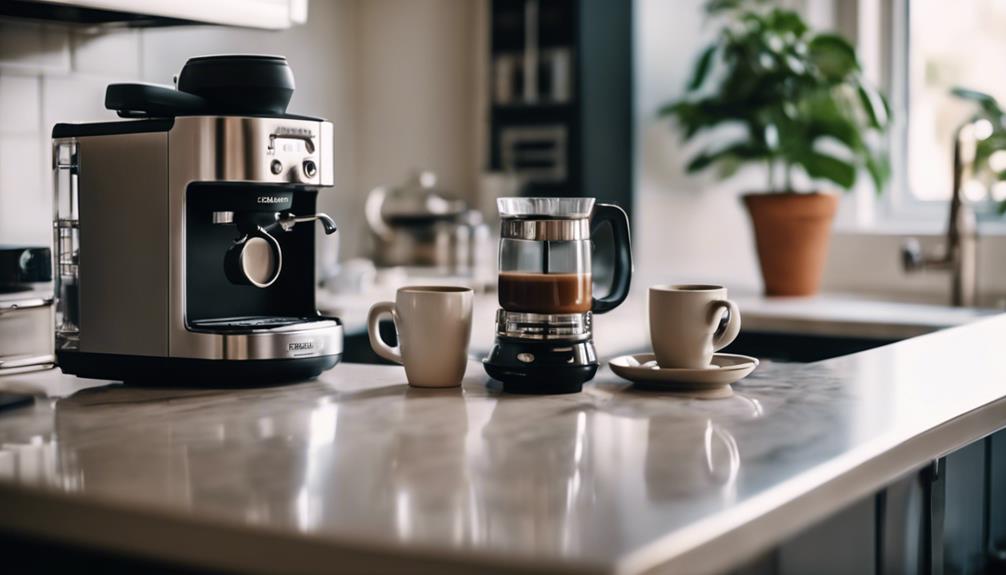
You're now the barista, bringing the coffee shop experience right into your own kitchen with the Breville Bambino's versatile capabilities.
With this machine, you can create a variety of coffee drinks that cater to your unique tastes. Whether you prefer a strong single shot or a rich double shot, the Breville Bambino has got you covered. You can use freshly ground coffee beans to make each shot, ensuring the best flavor possible.
The machine's quick setup and activation time of just three seconds mean you can enjoy your coffee without waiting around. Plus, with control over milk froth levels and temperature settings, you can customize your beverages to suit your taste.
Want a latte or cappuccino? No problem! The Breville Bambino makes it easy to create these popular coffee drinks at home. By using freshly frothed milk and expertly pulled shots, you'll be able to elevate your home coffee experience to new heights.
With the Breville Bambino, you'll be enjoying coffee shop-quality drinks in the comfort of your own home in no time.
Frequently Asked Questions
How to Make a Latte at Home With Breville Espresso Machine?
You're just a few steps away from a perfect latte! Start by brewing a double shot of espresso, then froth milk to your desired level using the steam wand, and combine for a beautiful layered effect.
Why Is Breville so Expensive?
You're likely wondering why Breville is pricey. It's due to the brand's focus on quality materials, innovative technology, and user-friendly features, which justify the higher cost for a premium coffee experience and long-term durability.
What Is the Best Grind Number for Breville Espresso?
You're seeking the perfect grind, balancing flavor and crema. Typically, a setting between 14 and 18 is ideal. You'll want to experiment, adjusting in small increments, to find your perfect shot, as you refine your espresso game.
Can You Put Ground Coffee in a Breville Espresso Machine Grinder?
You can't put ground coffee directly into the Breville Bambino's components, as it doesn't have a built-in grinder. Instead, you'll need to use a separate grinder to prepare the coffee before loading it into the machine.
Conclusion
You're now the maestro of your own coffee universe, with the Breville espresso maker as your trusted sidekick.
Just as a skilled artist weaves a masterpiece, you'll craft rich, velvety shots that awaken your senses.
As the aromatic espresso flows, imagine the morning sun bursting through your window, bathing your day in warmth and possibility.
Your coffee game has officially been elevated, and every sip is a reflection of your newfound mastery.
Espresso
What Is Espresso? Uncover the Secrets Behind This Bold Brew!
Behind the rich flavors and aromas of espresso lies a world of history, technique, and precision – discover its secrets.

You're about to discover the rich world of espresso, where a perfect blend of coffee beans, precise brewing techniques, and a dash of history come together to create a bold and complex brew. Espresso originated in 19th-century Italy, where innovators like Angelo Moriodo and Luigi Bezzera pioneered steam-driven coffee machines. To craft the perfect shot, you'll need high-quality beans, a balanced roast profile, and a fine grind size. With the right techniques and equipment, you can reveal the secrets of espresso and experience the vibrant flavors and aromas that make it a beloved morning ritual – and that's just the beginning.
Key Takeaways
- Espresso originated in 19th-century Italy, driven by increased coffee demand and the need for faster preparation.
- High-quality coffee beans, freshly roasted, yield rich flavor and aroma, with balanced roast profiles avoiding overly intense light roasts.
- The perfect brewing process involves optimal machine condition, fine grind size, consistent pressure, and peak extraction time of 25-30 seconds.
- Espresso brewing techniques require even tamping, ideal grind size, and proper extraction times for balanced flavor and improved extraction.
Origins of Espresso
When you explore the rich history of espresso, you'll find that it originated in 19th-century Italy as a response to the growing coffee demand and the need for faster coffee preparation in cafes. As coffee became an integral part of Italian culture, the need for a quicker brewing method became apparent.
Angelo Moriodo's invention of the first steam-driven coffee machine in 1884 marked the beginning of espresso's evolution. Luigi Bezzera improved upon Moriodo's design, using steam pressure to brew coffee, which laid the groundwork for modern espresso machines.
The term 'espresso' is derived from the Italian verb 'esprimere,' meaning 'to press out,' reflecting the method of extracting coffee rather than the speed of preparation. You might think that 'espresso' refers to the speed at which coffee is made, but it's actually about the process of forcing pressurized hot water through finely ground coffee.
Understanding the origins of espresso and its early innovators, like Moriodo and Bezzera, helps you appreciate the complexity of brewing coffee and the significance of Italy in shaping the world's coffee culture.
Delving into espresso's history can also help you refine your coffee palate and appreciation for the perfect cup.
The Perfect Brewing Process
To master the art of brewing espresso, you'll need to focus on several key elements that work together to create the perfect shot.
First, verify your espresso machine is in top condition, as it's the foundation of the brewing process.
Next, pay attention to the grind size of your coffee beans – a fine grind, similar to table salt, is ideal for even extraction and peak flavor.
When loading the portafilter, use 18-20 grams of coffee grounds for a single shot, which will result in a rich and concentrated brew.
Tamp the grounds with consistent pressure to promote balanced extraction and flavor.
Now, it's time to brew. The peak extraction time is between 25-30 seconds – too fast and the flavors will be weak, too slow and the shot will be bitter.
As you perfect the brewing process, you'll reveal the rich flavors that espresso has to offer.
With practice, you'll be able to coax out the unique characteristics of each coffee bean, creating a truly exceptional shot.
Ideal Coffee Bean Selection
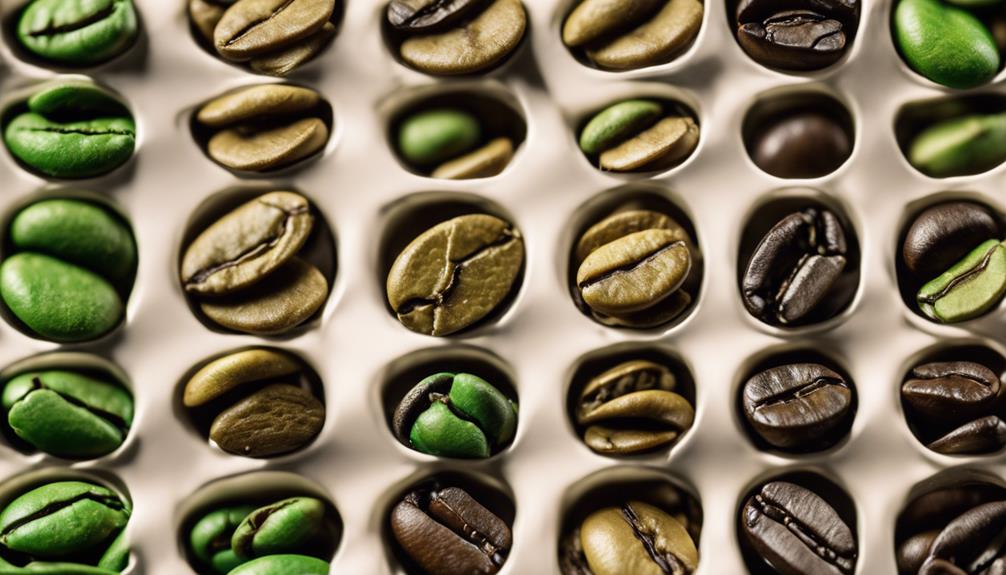
Selecting the right coffee beans is crucial for crafting exceptional espresso, and you'll want to focus on high-quality, freshly roasted beans that offer unique flavor profiles. When choosing beans, consider the roast profile and flavor profile you prefer. Here's a breakdown of key considerations:
| Bean Characteristics | Impact on Espresso |
|---|---|
| High-quality beans | Rich, vibrant flavor and aroma |
| Freshly roasted beans | Ideal flavor and aroma, with notes of fruit and chocolate |
| Balanced roast profile | Avoids overly intense light roasts, yielding a smooth, full-bodied espresso |
When selecting beans, you'll want to avoid those that are too light or too dark. Instead, opt for beans with a balanced roast profile that will yield a smooth, full-bodied espresso. High-quality beans are crucial for ideal flavor, and freshly roasted beans will guarantee the best possible taste. By choosing the right beans, you'll be well on your way to crafting exceptional espresso. Remember, the quality of the beans greatly influences espresso craftsmanship, so don't be afraid to experiment with different roast profiles and flavor profiles to find your perfect cup.
Espresso Roast Profile Explained
Now that you've selected the perfect coffee beans, it's time to explore the art of espresso roast profiles.
You'll want to understand the characteristics of espresso roasts, which are typically darker and roasted longer to bring out rich and bold flavors.
Espresso Roast Characteristics
When it comes to crafting the perfect espresso shot, understanding the nuances of espresso roast characteristics is key, as the roast profile plays a significant role in bringing out the desired flavors and aromas in your cup.
As you experiment with different espresso roast profiles, you'll discover that they often showcase a deeper, more caramelized flavor profile, thanks to the extended roasting time. However, keep in mind that achieving the perfect balance requires selecting the right type of coffee beans and fine-tuning your roast levels.
It's widely recognized that certain espresso beans – like lighter roasts – can yield overly intense flavors when brewed as espresso, resulting in a cup that's unbalanced and possibly bitter. Conversely, combining different coffee bean origins in the perfect proportion creates the magic blend you want.
That balance directly hinges on both beans you have to craft to effectively keep pace or resonate sound frequency. Yet, combining sound process procedures and putting the correct quantity can yield outstanding pure notes. This set blending produces the peak experience in your espresso.
Flavor Profile Balance
You're likely familiar with the concept that achieving a perfect balance in flavor profiles is vital for a great espresso experience, as it hinges on the delicate interplay between sweetness, acidity, and bitterness.
When it comes to espresso roast profiles, finding this balance is vital. Lighter roasts can be too intense if not roasted carefully, while darker roasts may become bitter if over-roasted. Adjusting roasting times and temperatures helps achieve the desired flavor balance, allowing for variations that cater to personal taste preferences.
To create a balanced espresso, roasters often blend different coffee grounds, including robusta beans, to enhance the caffeine content and introduce a fuller body. The ideal espresso roast profile should result in a harmonious combination of sweetness, acidity, and bitterness.
The presence of crema is a key indicator of the espresso's quality and flavor balance. By understanding how to balance flavor profiles, you'll be able to appreciate the nuances of different espresso roast profiles and find the perfect blend to suit your taste.
Whether you prefer a brighter, more acidic flavor or a richer, more robust taste, achieving flavor balance is vital for a great espresso experience.
Brewing Techniques and Tips
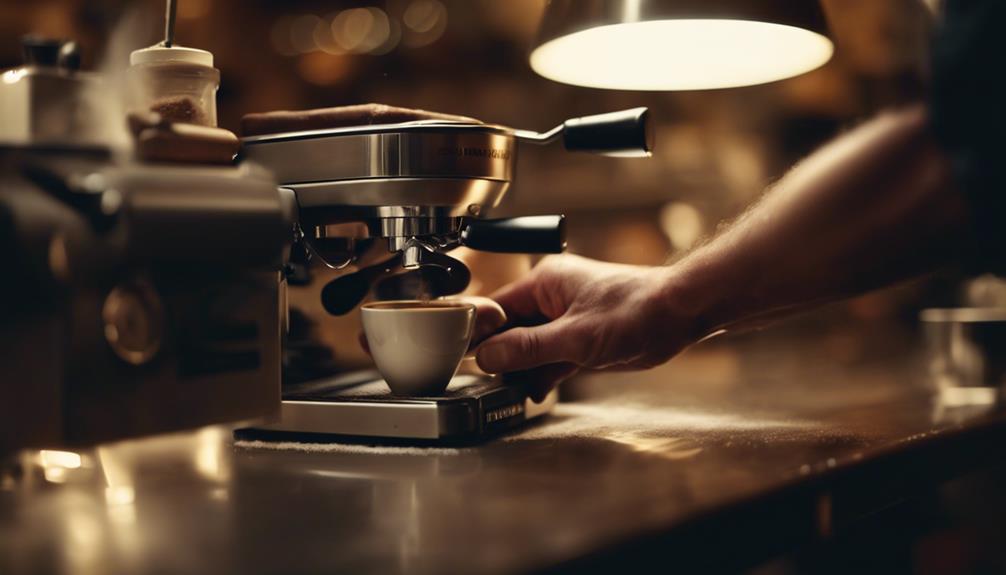
As you explore the world of espresso brewing, you'll quickly realize that perfecting the grind size is essential for achieving that perfect shot.
Mastering the grind size requires attention to detail and a bit of experimentation to find the ideal consistency.
Perfecting the Grind Size
To perfect the grind size for espresso, it's crucial to aim for a fine grind, similar to table salt, which is necessary for ideal extraction and rich flavor.
As you work to master the grind size, consider these key factors to optimize your brewing experience:
- Uniformity is key, and a burr grinder can help achieve the consistency needed for even extraction.
- A fine grind can enhance extraction but can also lead to bitterness if over-extracted.
- For a single shot of espresso, the ideal dose is between 18-20 grams of ground coffee, making precise measurements in grinding essential.
- Experimenting with different grind sizes affects the flavor profile; adjusting this is part of fine-tuning the espresso shot.
Keep these aspects in mind, and remember, fine-tuning your grind size with each use can guarantee your ground coffee complements your burr grinder for an unparalleled shot of espresso every time.
With consistent experimentation, you can enjoy that bold flavor everyone wants to know more about – every shot will deliver perfect and engaging outcomes in mastering that strong blend in brew form!
Mastering Brewing Techniques
Mastering brewing techniques is crucial for releasing the full flavor potential of your espresso, and it starts with understanding the importance of even tamping and precise water temperature control. When you tamp the coffee grounds evenly, you guarantee a balanced flavor profile and improved extraction quality. Additionally, monitoring the water temperature between 195-205°F during brewing is imperative, as this range greatly impacts the final taste of the espresso.
To achieve the perfect coffee, consider the following brewing techniques:
| Brewing Method | Water Temperature | Coffee-to-Water Ratio |
|---|---|---|
| Espresso | 195-205°F | 1:2 |
| Pour-over | 200-210°F | 1:15 |
| French press | 195-205°F | 1:12 |
When brewing espresso, use 18-20 grams of coffee grounds in the portafilter and aim for an extraction time of 25-30 seconds. This will prevent weak flavors from fast extractions or bitterness from slow extractions. By mastering these brewing techniques, you'll be able to bring out the unique flavors of your favorite beans and enjoy a perfect cup of coffee every time. With practice and patience, you'll become a skilled barista, capable of crafting exceptional espresso shots that impress even the most discerning coffee connoisseurs.
Fun Facts and Trivia
Discovering the lesser-known facts behind your favorite morning shot of espresso reveals a complex beverage that's full of surprising details, ranging from its etymology to brewing methods and misconceptions surrounding it.
As you sip on your espresso, you might be wondering what makes it so unique. Let's explore some fun facts and trivia that'll make you appreciate your daily cup even more.
Here are a few interesting tidbits about espresso:
- Espresso doesn't actually mean 'express' in Italian, but rather 'to press out' from the verb 'esprimere'.
- You might think espresso has more caffeine than filter coffee, but a standard serving of espresso actually contains less caffeine overall.
- Italian regulations require specific criteria for a shot of espresso to be considered true espresso, including minimum brewing pressure and extraction time.
- Historically, espresso blends often included robusta beans to increase caffeine content and enhance crema.
These facts show that there's more to espresso than just its bold flavors and rich aromas.
Whether you're a coffee connoisseur or just a casual fan, understanding the intricacies of espresso can enhance your appreciation for this beloved beverage.
Frequently Asked Questions
What Scientists Claim to Have Discovered the Secret to Perfect Espresso?
You're about to uncover the secret to perfect espresso! Scientists claim to have discovered that adding water before grinding coffee beans enhances consistency and taste, reducing static electricity and waste, and leading to stronger flavor extraction.
What Is Bold Espresso?
"Variety is the spice of life," and when it comes to bold espresso, you're in for a treat. You're brewing a concentrated coffee by forcing hot water through finely ground beans, resulting in a rich, strong flavor.
How Is Espresso Different From Coffee?
You're probably wondering how espresso differs from regular coffee. The main differences lie in brewing pressure, grind size, extraction time, and serving size, resulting in a richer, more intense flavor and a unique crema layer in espresso.
What Is the Difference Between Bold and Strong Coffee?
You might've noticed how some friends order "bold" coffee, while others ask for "strong" coffee. What's the difference? Think of it like music – bold coffee is like a rich, complex symphony, while strong coffee is more like a loud, intense beat.
Conclusion
As you wrap up your espresso journey, it's no coincidence that you've discovered the perfect blend of art and science.
The rich flavors and bold aromas have likely left you wondering how something so small can pack such a punch.
It's a coincidence that the same passion and dedication that goes into crafting each shot is the same passion that drives you to savor every last drop.
-

 Coffee Guides2 weeks ago
Coffee Guides2 weeks agoBoost Your Coffee: Easy Ways to Enhance Your Brew
-
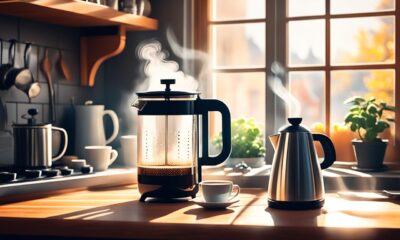
 Coffee Guides2 weeks ago
Coffee Guides2 weeks agoBrew Perfect Coffee at Home: Expert Tips & Tricks
-

 Health and Wellness2 weeks ago
Health and Wellness2 weeks agoHeadache-Free: How to Avoid Coffee Headaches!
-

 Vetted2 weeks ago
Vetted2 weeks ago15 Best Trundle Beds for Maximizing Space and Style in Your Home
-

 Coffee Guides2 weeks ago
Coffee Guides2 weeks agoBecome a Coffee Master: Expert Brewing Tips
-

 Coffee Guides2 weeks ago
Coffee Guides2 weeks agoBreve Coffee Explained: Your Cozy Café Favorite
-

 Coffee Guides2 weeks ago
Coffee Guides2 weeks agoHow to Be a Coffee Cup: Embrace Your Inner Brew
-

 Vetted2 weeks ago
Vetted2 weeks ago15 Best Cordless Pool Vacuums for Effortless Pool Cleaning
















